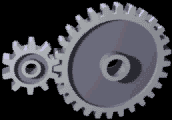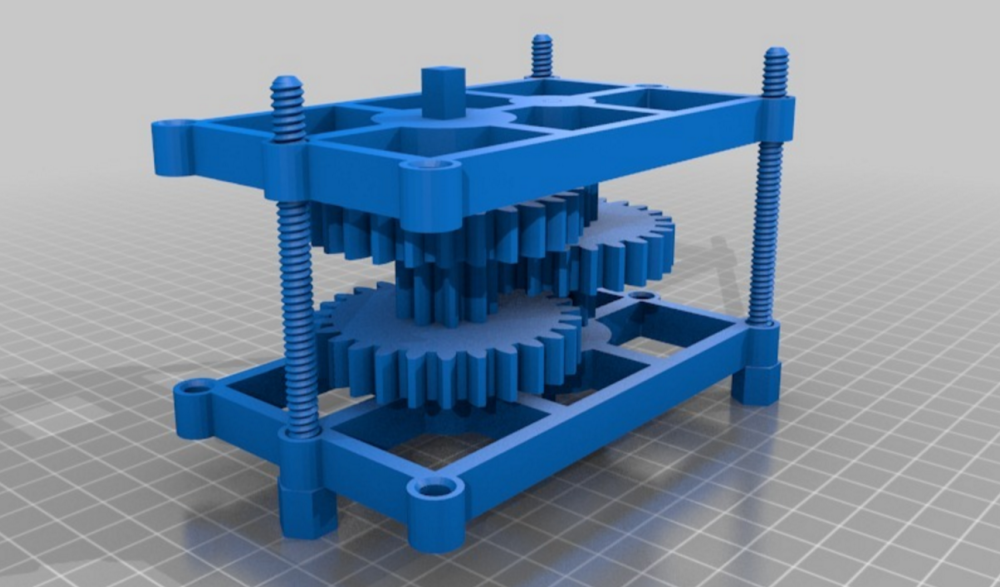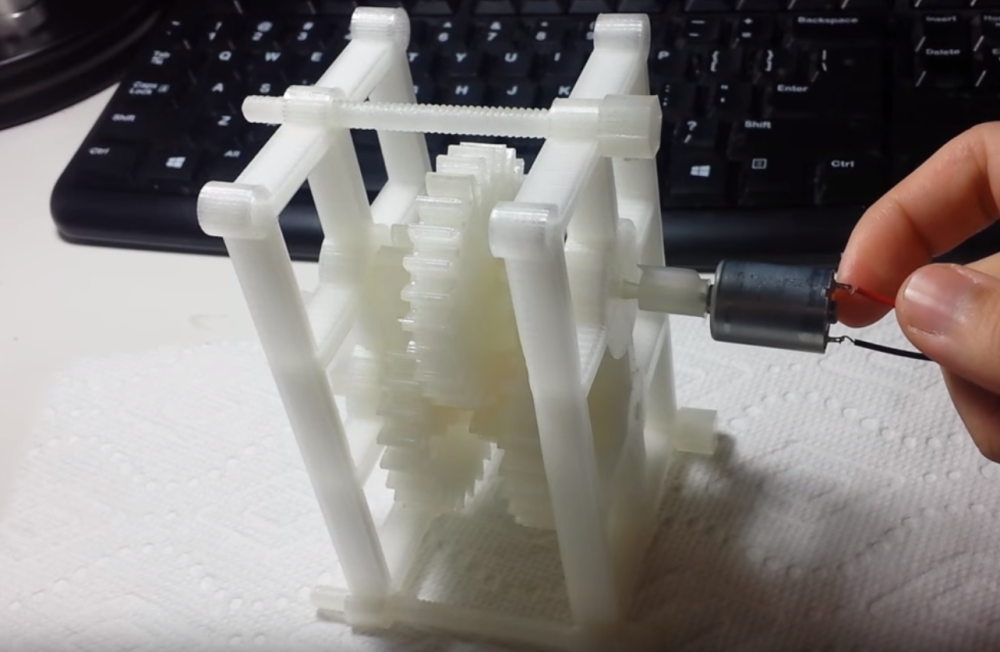 The concept of a gear train is a rather simple one: there are two wheels with teeth on them that when connected can be used to drive or move a machine of some kind. The motion is controlled by driving one of the gears, usually the smaller of the two, which will cause the larger gear to move along with it. The teeth on the gears are designed with a specific pitch that prevents them from getting stuck together while still rolling together without slipping. If the gears are designed correctly, then the result will be a smooth transmission of rotation from the drive gear to the larger gear.
The concept of a gear train is a rather simple one: there are two wheels with teeth on them that when connected can be used to drive or move a machine of some kind. The motion is controlled by driving one of the gears, usually the smaller of the two, which will cause the larger gear to move along with it. The teeth on the gears are designed with a specific pitch that prevents them from getting stuck together while still rolling together without slipping. If the gears are designed correctly, then the result will be a smooth transmission of rotation from the drive gear to the larger gear.
 While the gear certainly doesn’t date back as far as the wheel, it is one of the earliest mechanical systems designed by man. There are examples of ancient geared mechanisms dating back as far as the 300 BC throughout Asia and 100 BC in ancient Greece. However the technology wasn’t widely used until much later when primitive gears were used to drive water mills or to grind grain. Of course more complex version of a reduction gear train can be found in geared bicycles, automobile transmissions, farming equipment and even the smaller versions used in watches.
While the gear certainly doesn’t date back as far as the wheel, it is one of the earliest mechanical systems designed by man. There are examples of ancient geared mechanisms dating back as far as the 300 BC throughout Asia and 100 BC in ancient Greece. However the technology wasn’t widely used until much later when primitive gears were used to drive water mills or to grind grain. Of course more complex version of a reduction gear train can be found in geared bicycles, automobile transmissions, farming equipment and even the smaller versions used in watches.
When maker and Thingiverse user ManWithoutOptions decided to build his own peristaltic pump he needed something to drive the water through the device. Of course there are plenty of small, inexpensive, low torque motors that have reduction gears built into them, but he decided to see if he could do it himself. He initially checked Thingiverse to see if there were any reduction gears available, but he found that they need to produce too much internal friction, which would make them impossible to be driven by the small toy DC motor that he wanted to use. But he took inspiration from their designs and tweaked them until he came up with a gear design that worked perfectly with his little motor.
“I am in the process of building a peristaltic pump. I need a workforce source with sufficient torque to drive the water. I could use a 10 dollar motor with reduction gear built in…but I have a 3d printer so why not DIY. It only take 12 hours in one go to print all the parts and 5mins to assemble. Reduction gear is what make these useless cheap toy motor like these into actual workforce,” he explained.
 According to ManWithoutOptions all of the parts for the reduction gear train that he created took him about twelve hours to print. All of the parts needed to be filed and smoothed so the gears would fit together well enough to rotate without the surface texture providing resistance. By necessity the top plate and the output axle was designed as a very tight fit, so ManWithoutOptions suggests that they be given special attention when filing and smoothing. But once the gears were smoothed out the actual assembly only took him about five minutes. In order for the gears to move correctly without getting stuck, or worse melting and deforming the plastic, all of the parts need to be heavily lubricated.
According to ManWithoutOptions all of the parts for the reduction gear train that he created took him about twelve hours to print. All of the parts needed to be filed and smoothed so the gears would fit together well enough to rotate without the surface texture providing resistance. By necessity the top plate and the output axle was designed as a very tight fit, so ManWithoutOptions suggests that they be given special attention when filing and smoothing. But once the gears were smoothed out the actual assembly only took him about five minutes. In order for the gears to move correctly without getting stuck, or worse melting and deforming the plastic, all of the parts need to be heavily lubricated.
 All of the 3D models already have support structures built into them, so there shouldn’t need to be any additional supports generated for them. ManWithoutOptions suggests that the maximum layer height used to 3D print the parts is 0.2mm, however he 3D printed his parts with a 0.1mm resolution. The parts should be 3D printable on just about any brand 3D printer, however ManWithoutOptions used his Ultimaker 2. Obviously don’t try to 3D print the “Entire Assembly” STL file included on the reduction gear Thing page, as it is simply for reference and will not print correctly.
All of the 3D models already have support structures built into them, so there shouldn’t need to be any additional supports generated for them. ManWithoutOptions suggests that the maximum layer height used to 3D print the parts is 0.2mm, however he 3D printed his parts with a 0.1mm resolution. The parts should be 3D printable on just about any brand 3D printer, however ManWithoutOptions used his Ultimaker 2. Obviously don’t try to 3D print the “Entire Assembly” STL file included on the reduction gear Thing page, as it is simply for reference and will not print correctly.
You can take a look at ManWithoutOptions using his small DC motor to run his reduction gear here:
While this probably isn’t going to be the best option for running a device that needs a geared motor, it is still a great project for anyone interested in learning how a geared motor works. It would be ideal for school environments, or just a maker looking to experiment. You can find out more about ManWithoutOptions’ project by checking out the assembly and printing instructions over on Thingiverse, or reading through his post on Reddit. Discuss in the 3D Printed Reduction Gear forum over at 3DPB.com.
Subscribe to Our Email Newsletter
Stay up-to-date on all the latest news from the 3D printing industry and receive information and offers from third party vendors.
You May Also Like
3D Printing Unpeeled: $5000 Cold Spray 3D Printer, Roland DGA & Living Materials
The AeroForge is a $5000 cold spray metal printer for copper made by a student team at Rice University. In a paper for ACS Central Science a team from Nanjing...
3D Printing Webinar and Event Roundup: April 28, 2024
In this week’s 3D Printing Webinar and Event Roundup, the Ceramics Expo is taking place in Michigan, Stratasys continues its advanced training courses, and SPE is holding a Polymer Characterization...
Meltio Expands Global Reach with New Partnerships in the Americas and Europe
Spanish 3D printing manufacturer Meltio has expanded its sales network across the globe. With the addition of three new partners in the United States, Brazil, Argentina, and Italy, Meltio aims...
US Army Corps of Engineers Taps Lincoln Electric & Eaton for Largest 3D Printed US Civil Works Part
The Soo Locks sit on the US-Canadian border, enabling maritime travel between Lake Superior and Lake Huron, from which ships can reach the rest of the Great Lakes. Crafts carrying...






























